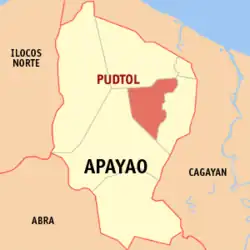Pudtol
Tawit | |
|---|---|
| Municipality of Pudtol | |
 Pudtol Church ruins | |
 Flag | |
 Map of Apayao with Pudtol highlighted | |
OpenStreetMap | |
.svg.png.webp) Pudtol Location within the Philippines | |
| Coordinates: 18°14′08″N 121°22′24″E / 18.2356°N 121.3733°E | |
| Country | Philippines |
| Region | Cordillera Administrative Region |
| Province | Apayao |
| District | Lone district |
| Barangays | 22 (see Barangays) |
| Government | |
| • Type | Sangguniang Bayan |
| • Mayor | Hector Reuel D. Pascua (PDPLBN) |
| • Vice Mayor | Randy A. Laoat (PDPLBN) |
| • Representative | Eleanor Bulut-Begtang |
| • Municipal Council | Members |
| • Electorate | 9,692 voters (2022) |
| Area | |
| • Total | 401.02 km2 (154.83 sq mi) |
| Elevation | 37 m (121 ft) |
| Highest elevation | 183 m (600 ft) |
| Lowest elevation | 6 m (20 ft) |
| Population (2020 census)[3] | |
| • Total | 15,491 |
| • Density | 39/km2 (100/sq mi) |
| • Households | 3,608 |
| Economy | |
| • Income class | 4th municipal income class |
| • Poverty incidence | 21.01 |
| • Revenue | ₱ 145.1 million (2020) |
| • Assets | ₱ 246.8 million (2020) |
| • Expenditure | ₱ 110 million (2020) |
| • Liabilities | ₱ 124.8 million (2020) |
| Service provider | |
| • Electricity | Kalinga - Apayao Electric Cooperative (KAELCO) |
| Time zone | UTC+8 (PST) |
| ZIP code | 3812 |
| PSGC | |
| IDD : area code | +63 (0)74 |
| Native languages | Ilocano Tagalog |
Pudtol, officially the Municipality of Pudtol, (Ilocano: Ili ti Pudtol; Tagalog: Bayan ng Pudtol), is a 4th class municipality in the province of Apayao, Philippines. According to the 2020 census, it has a population of 15,491 people.[3]
History
Pudtol, taken from Luna, was created as a municipal district on December 3, 1956 through executive order no. 217.[5][6][7] Prior to that, Pudtol was a sign of a Spanish mission.
It consisted of the last remaining territories of municipal district of Tauit (the first sub-provincial capital of Apayao), which was abolished on January 21, 1936 through EO No. 13 and annexed as a single barrio to Luna.[5][6][8][9] Tauit also comprised the present-day municipalities of Luna, Santa Marcela, Flora, and some parts of Lasam and Allacapan.[10]
Barangays Aga, Cacalaggan, Malibang and Matanguisi are comprised by then-Barrio Tawit, Tauit's seat of government.[5][9]
On March 31, 1959, Pudtol was converted into a municipality by virtue of executive order no. 335.[6][11]
On June 22, 1963, via Republic Act No. 3672, several barrios and sitios were separated from Pudtol and constituted into the newly created municipality of Flora.[12]
Geography
According to the Philippine Statistics Authority, the municipality has a land area of 401.02 square kilometres (154.83 sq mi) [13] constituting 9.09% of the 4,413.35-square-kilometre- (1,704.00 sq mi) total area of Apayao.
Barangays
Pudtol is politically subdivided into 22 barangays.[14] Each barangay consists of puroks and some have sitios.
| PSGC | Barangay | Population | ±% p.a. | |||
|---|---|---|---|---|---|---|
| 2020[3] | 2010[15] | |||||
| 148106001 | Aga | 2.2% | 343 | 276 | 2.20% | |
| 148106002 | Alem | 5.5% | 855 | 875 | −0.23% | |
| 148106022 | Amado | 5.2% | 802 | 791 | 0.14% | |
| 148106023 | Aurora | 2.3% | 355 | 296 | 1.83% | |
| 148106006 | Cabatacan | 9.9% | 1,529 | 1,313 | 1.53% | |
| 148106007 | Cacalaggan | 3.3% | 513 | 405 | 2.39% | |
| 148106009 | Capannikian | 8.9% | 1,381 | 1,192 | 1.48% | |
| 148106024 | Doña Loreta | 4.8% | 737 | 711 | 0.36% | |
| 148106025 | Emilia | 3.5% | 537 | 427 | 2.32% | |
| 148106026 | Imelda | 4.0% | 621 | 552 | 1.18% | |
| 148106010 | Lower Maton | 2.4% | 369 | 345 | 0.67% | |
| 148106027 | Lt. Balag | 1.4% | 214 | 176 | 1.97% | |
| 148106028 | Lydia | 4.0% | 624 | 529 | 1.67% | |
| 148106012 | Malibang | 3.5% | 539 | 472 | 1.34% | |
| 148106014 | Mataguisi | 6.5% | 1,004 | 807 | 2.21% | |
| 148106016 | Poblacion | 5.9% | 911 | 836 | 0.86% | |
| 148106017 | San Antonio (Pugo) | 1.2% | 186 | 171 | 0.84% | |
| 148106029 | San Jose | 2.2% | 344 | 361 | −0.48% | |
| 148106030 | San Luis | 5.0% | 772 | 683 | 1.23% | |
| 148106031 | San Mariano | 2.4% | 377 | 463 | −2.03% | |
| 148106020 | Swan | 9.7% | 1,503 | 1,253 | 1.84% | |
| 148106021 | Upper Maton | 2.6% | 409 | 371 | 0.98% | |
| Total | 15,491 | 13,305 | 1.53% | |||
Climate
| Climate data for Pudtol, Apayao | |||||||||||||
|---|---|---|---|---|---|---|---|---|---|---|---|---|---|
| Month | Jan | Feb | Mar | Apr | May | Jun | Jul | Aug | Sep | Oct | Nov | Dec | Year |
| Mean daily maximum °C (°F) | 25 (77) |
26 (79) |
28 (82) |
31 (88) |
31 (88) |
31 (88) |
30 (86) |
30 (86) |
30 (86) |
28 (82) |
27 (81) |
25 (77) |
29 (83) |
| Mean daily minimum °C (°F) | 20 (68) |
20 (68) |
21 (70) |
22 (72) |
24 (75) |
25 (77) |
24 (75) |
24 (75) |
24 (75) |
23 (73) |
22 (72) |
21 (70) |
23 (73) |
| Average precipitation mm (inches) | 120 (4.7) |
77 (3.0) |
62 (2.4) |
40 (1.6) |
118 (4.6) |
138 (5.4) |
162 (6.4) |
173 (6.8) |
143 (5.6) |
198 (7.8) |
185 (7.3) |
248 (9.8) |
1,664 (65.4) |
| Average rainy days | 16.9 | 12.2 | 11.5 | 10.6 | 18.7 | 20.1 | 21.2 | 23.3 | 20.8 | 16.9 | 16.5 | 20.0 | 208.7 |
| Source: Meteoblue[16] | |||||||||||||
Demographics
| Year | Pop. | ±% p.a. |
|---|---|---|
| 1960 | 7,720 | — |
| 1970 | 5,735 | −2.93% |
| 1975 | 6,547 | +2.69% |
| 1980 | 7,598 | +3.02% |
| 1990 | 7,621 | +0.03% |
| 1995 | 8,656 | +2.41% |
| 2000 | 11,039 | +5.35% |
| 2007 | 12,595 | +1.84% |
| 2010 | 13,305 | +2.02% |
| 2015 | 14,925 | +2.21% |
| 2020 | 15,491 | +0.73% |
| Source: Philippine Statistics Authority[17][15][18][19] | ||
In the 2020 census, Pudtol had a population of 15,491.[3] The population density was 39 inhabitants per square kilometre (100/sq mi).
Economy
Government
Local government
Pudtol, belonging to the lone congressional district of the province of Apayao, is governed by a mayor designated as its local chief executive and by a municipal council as its legislative body in accordance with the Local Government Code. The mayor, vice mayor, and the councilors are elected directly by the people through an election which is being held every three years.
Elected officials
| Position | Name |
|---|---|
| Congressman | Elias C. Bulut Jr. |
| Mayor | Hector Reuel D. Pascua |
| Vice-Mayor | Randy A. Laoat |
| Councilors | Ricky A. Laoat |
| Albert M. Buyag | |
| Edaño T. Patayan | |
| Loreto C. Pascua | |
| Edison A. Caluducan | |
| Elmer P. Canonizado | |
| Cleofil C. Collado | |
| Dennis C. Sinfuego | |
References
- ↑ Municipality of Pudtol | (DILG)
- ↑ "2015 Census of Population, Report No. 3 – Population, Land Area, and Population Density" (PDF). Philippine Statistics Authority. Quezon City, Philippines. August 2016. ISSN 0117-1453. Archived (PDF) from the original on May 25, 2021. Retrieved July 16, 2021.
- 1 2 3 4 Census of Population (2020). "Cordillera Administrative Region (CAR)". Total Population by Province, City, Municipality and Barangay. Philippine Statistics Authority. Retrieved 8 July 2021.
- ↑ "PSA Releases the 2018 Municipal and City Level Poverty Estimates". Philippine Statistics Authority. 15 December 2021. Retrieved 22 January 2022.
- 1 2 3 Pudtol - A Brief History Retrieved July 26, 2022.
- 1 2 3 "Pudtol: Executive Summary, 2019" (PDF) Commission on Audit. Retrieved Aug. 1, 2022.
- ↑ "Executive Order No. 217, s. 1956" Official Gazette. Retrieved July 26, 2022.
- ↑ "Executive Order No. 13, s. 1936" Official Gazette. Retrieved July 26, 2022.
- 1 2 History and government of Luna, Apayao (via Department of the Interior and Local Government–CAR). Retrieved July 28, 2022.
- ↑ "Brief History of Pudtol" Municipality of Pudtol. Retrieved Aug. 1, 2022.
- ↑ "Executive Order No. 335, s. 1959" Official Gazette. Retrieved July 26, 2022.
- ↑ "Republic Act No. 3672". Chan Robles Virtual Law Library. 22 June 1963. Archived from the original on 26 September 2013. Retrieved 4 November 2016.
- ↑ "Province: Apayao". PSGC Interactive. Quezon City, Philippines: Philippine Statistics Authority. Retrieved 12 November 2016.
- ↑ "Municipal: Pudtol". PSGC Interactive. Quezon City, Philippines: Philippine Statistics Authority. Retrieved 8 January 2016.
- 1 2 Census of Population and Housing (2010). "Cordillera Administrative Region (CAR)" (PDF). Total Population by Province, City, Municipality and Barangay. National Statistics Office. Retrieved 29 June 2016.
- ↑ "Pudtol: Average Temperatures and Rainfall". Meteoblue. Retrieved 8 March 2020.
- ↑ Census of Population (2015). "Cordillera Administrative Region (CAR)". Total Population by Province, City, Municipality and Barangay. Philippine Statistics Authority. Retrieved 20 June 2016.
- ↑ Censuses of Population (1903–2007). "Cordillera Administrative Region (CAR)". Table 1. Population Enumerated in Various Censuses by Province/Highly Urbanized City: 1903 to 2007. National Statistics Office.
{{cite encyclopedia}}: CS1 maint: numeric names: authors list (link) - ↑ "Province of Apayao". Municipality Population Data. Local Water Utilities Administration Research Division. Retrieved 17 December 2016.
- ↑ "Poverty incidence (PI):". Philippine Statistics Authority. Retrieved December 28, 2020.
- ↑ "Estimation of Local Poverty in the Philippines" (PDF). Philippine Statistics Authority. 29 November 2005.
- ↑ "2003 City and Municipal Level Poverty Estimates" (PDF). Philippine Statistics Authority. 23 March 2009.
- ↑ "City and Municipal Level Poverty Estimates; 2006 and 2009" (PDF). Philippine Statistics Authority. 3 August 2012.
- ↑ "2012 Municipal and City Level Poverty Estimates" (PDF). Philippine Statistics Authority. 31 May 2016.
- ↑ "Municipal and City Level Small Area Poverty Estimates; 2009, 2012 and 2015". Philippine Statistics Authority. 10 July 2019.
- ↑ "PSA Releases the 2018 Municipal and City Level Poverty Estimates". Philippine Statistics Authority. 15 December 2021. Retrieved 22 January 2022.
- ↑ "2019 National and Local Elections" (PDF). Commission on Elections. Retrieved March 12, 2022.
External links
![]() Media related to Pudtol at Wikimedia Commons
Media related to Pudtol at Wikimedia Commons